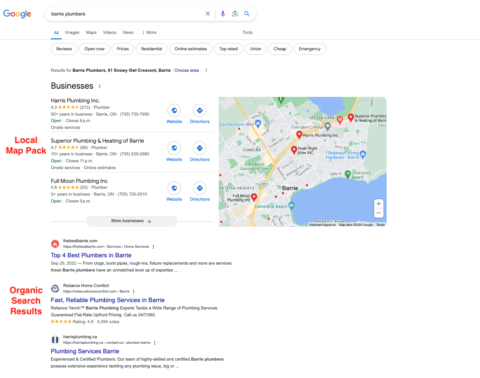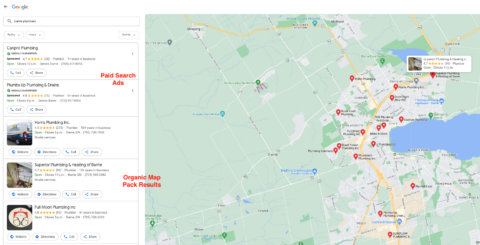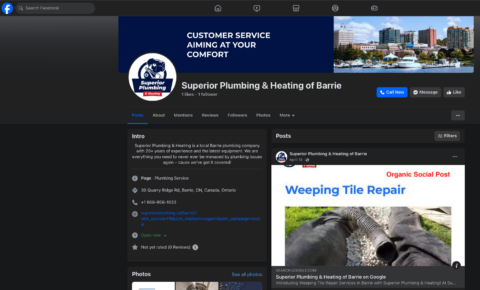

Last updated on

Local business owners frequently encounter a common dilemma in digital marketing.
With a plethora of choices expanding almost daily, compounded by the integration of AI, determining the optimal and most efficient approach for your business can be challenging.
At the outset, local businesses typically weigh two (or technically four) main avenues: organic and paid strategies across search engines and social media platforms.
This guide will delve into the intricacies of each avenue, evaluate their advantages and disadvantages, and provide practical advice to aid in making well-informed decisions about where to allocate your valuable time, resources, and budget.
Let’s begin by outlining the fundamental distinction between organic and paid strategies:
Organic: This approach centers on cultivating long-term brand awareness, trust, and authority through consistent creation and distribution of high-quality, optimized content and active community engagement. It focuses on nurturing a loyal customer base, which naturally demands dedicated time and effort.
Paid: This strategy involves investing in online advertising campaigns to gain immediate visibility and reach a broader audience swiftly. While it offers a shortcut to visibility, it necessitates careful management to balance costs against lead volume and quality.
For local business owners navigating both search and social media platforms, the choice between organic and paid strategies involves weighing considerations of time, resources, and initial implementation costs against anticipated results.
In the following sections, we’ll delve into essential best practices for achieving success, along with a comprehensive look at the advantages and disadvantages of each strategy.
While not explicitly highlighted as a best practice, it’s crucial to understand that ongoing monitoring and optimization are essential for adapting strategies based on desired outcomes and performance—a critical component of effective digital marketing efforts.
The term “search engine marketing” is often mistakenly associated exclusively with paid strategies. However, it should actually be recognized as the umbrella term encompassing both organic search (local SEO) and paid search (PPC).
The objective of local SEO is to ensure that your business prominently appears in the Local Map Pack and/or organic search results when potential customers search for the services or products you offer.

Local SEO shares similarities with traditional SEO but involves additional steps to optimize effectively.
Best Practices:
Pros:
Cons:
Some argue that establishing local authority and visibility is closely tied to running a reputable business, providing excellent services, and actively engaging with the community.
Well-managed local businesses that effectively engage in local SEO have the opportunity to be discovered by their customers through organic search results.
Paid search encompasses the creation and distribution of compelling text, image, or video ads (including YouTube) on Google or Bing’s search and display networks. These ads are linked to conversion-oriented standalone pages or website landing pages.
On a local scale, service-oriented businesses can opt for Google Local Services Ads, which involve a verification process for qualified businesses.

Best Practices:
Pros:
Cons:
Social media is ubiquitous in our modern world, impacting businesses of all sizes. Yet, many local businesses remain uncertain about its role in their marketing strategies.
The key lies in understanding your business’s nature and your audience’s preferences. Can you produce content suitable for platforms such as Facebook, Instagram, or TikTok? Will your audience actively seek out this content on these channels?
For most local businesses, embracing social media offers a valuable opportunity to extend their community presence online.
Organic social media involves sharing text, images, audio, video, and/or links across various social media platforms.
To ensure this content reaches and resonates with your audience, it’s crucial to cultivate a social following—a step often overlooked in social media marketing.

Best Practices:
Pros
Cons
Paid social media advertising, similar to paid search, allows for text, image, or video ads to be distributed on social networks where your audience is most engaged.

Best Practices
Pros
Cons
Regardless of the chosen tactic, local business owners need to acknowledge and address several challenges.
The most effective approach for your local business will depend on your specific goals, budget, and target audience. When assessing your options, consider the following factors:
A well-rounded digital marketing strategy often involves a combination of organic and paid tactics. It’s not about choosing organic vs. paid, but rather integrating both for optimal results.
A common and effective approach is to identify organic keywords or topics where your business already has some level of authority and visibility, from which you are receiving traffic and can build upon.
This might involve a unique product or service you offer, or something particularly popular with your customers. Focus your local SEO efforts on these areas.
Simultaneously, identify high-value, low-competition keywords worth paying for through PPC or paid social ads, ensuring they deliver quick and meaningful results.
Another strategy is to use paid search or social ads as a testing ground. This helps you understand which keywords or topics resonate with your audience and on which channels before committing to a comprehensive organic content strategy.
If your budget allows for a comprehensive approach, integrate both paid search and paid social into your digital marketing strategy. Use paid search to capture high-intent users actively searching for your products or services, and paid social to build brand awareness, nurture leads, and reach a broader audience.
Digital marketing has risen in prominence not just due to growing consumer expectations for instant results, but also because of the profound influence of data on every online interaction.
Despite being occasionally overwhelming, digital marketing allows for meticulous tracking, analysis, and optimization of strategies based on real-time performance insights.
For instance, website interactions and inbound traffic can be monitored using tools like Google Analytics. PPC advertisements provide comprehensive data on impressions, clicks, and conversions through platforms such as Google Adwords and Bing Ads. Moreover, nearly all paid social media platforms offer detailed tracking features.
For small businesses, it could be as straightforward as knowing the number of leads or paying customers coming from online channels.
Yet, the more precise data you gather about the specific channels bringing customers to your online store or physical location, the more insightful it becomes.
The ultimate goal is to accurately gauge the return on investment from each channel. Even approaching this goal helps affirm the validity of your strategic choices.
Ultimately, determining which strategies best suit your specific needs will be your decision and will undoubtedly necessitate refinement over time.
By grasping the actual expenses, advantages, and disadvantages of each method, you can craft a well-rounded approach that yields measurable outcomes.
Original news from SearchEngineJournal